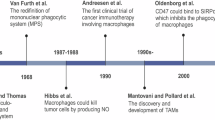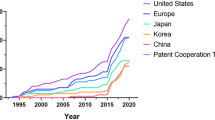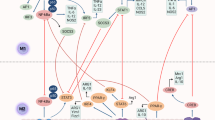Abstract
Macrophage activation—enhanced capacity to kill, in a cell that otherwise mostly scavenges—is essential for host survival from infection and contributes to containment of tumours. Both microbes and tumour cells, therefore, may be under pressure to inhibit or reverse the activation of macrophages. This reasoning led to the demonstration of macrophage deactivating factors from both microbes1,2 and tumour cells3–5. In some circumstances the host itself probably requires the ability to deactivate macrophages. Macrophages are essential to the healing of wounds and repair of tissues damaged by inflammation. Yet the cytotoxic products of the activated macrophages can damage endothelium, fibroblasts, smooth muscle and parenchymal cells (reviewed in ref. 6). Thus, after an inflammatory site has been sterilized, the impact of macrophage activation on the host might shift from benefit to detriment. These concepts led us to search for macrophage deactivating effects among polypeptide growth factors that regulate angiogenesis, fibrogenesis and other aspects of tissue repair. Among 11 such factors, two proteins that are 71% similar proved to be potent macrophage deactivators: these are transforming growth factor-β1 (TGF- β1) and TGF- β2.
This is a preview of subscription content, access via your institution
Access options
Subscribe to this journal
Receive 51 print issues and online access
$199.00 per year
only $3.90 per issue
Buy this article
- Purchase on SpringerLink
- Instant access to full article PDF
Prices may be subject to local taxes which are calculated during checkout
Similar content being viewed by others
References
Confer, D. L. & Eaton, J. W. Science 217, 948–950 (1982).
Ding, A. H. & Nathan, C. F. J. lmmun. 139, 1971–1977 (1987).
Szuro-Sudol, A. & Nathan, C. F. J. exp. Med. 156, 945–961 (1982).
Szuro-Sudol, A., Murray, H. W. & Nathan, C. F. J. Immun. 131, 384–387 (1983).
Tsunawaki, S. & Nathan, C. F. J. exp. Med. 164, 1319–1331 (1986).
Cross, C. E. et al. Ann. int. Med. 107, 526–545 (1987).
Nathan, C. F. Trans. R. Soc. trop. Med. Hyg. 77, 620–630 (1983).
de la Harpe, J. & Nathan, C. F. J. immun. Meth. 78, 323–325 (1985).
Murray, H. W., Spitalny, G. & Nathan, C. F. J. Immun. 134, 1619–1622 (1985).
Shparber, M. & Nathan, C. F. Blood 68, 86a (1986).
Nathan, C. F. & Terry, W. D. Cell. Immun. 29, 295–311 (1977).
Derynck, R. et al. Nature 316, 701–705 (1985).
Kehrl, J. H. et al. J. exp. Med. 163, 1037–1050 (1986).
Sporn, M. B., Roberts, A. B., Wakefield, L. M. & Assoian, R. K. Science 233, 532–534 (1986).
Massague, J. Cell 49, 437–438 (1987).
Akhurst, R. J., Fee, F. & Balmain, A. Nature 331, 363–365 (1988).
Dvorak, H. F. New Engl. J. Med. 315, 1650–1659 (1986).
Assoian, R. K. et al. Proc. natn. Acad. Sci. U.S.A. 84, 6020–6024 (1987).
Reed, S. G. et al. J. exp. Med. 166, 1734–1746 (1987).
Wahl, S. M. et al. Proc. natn. Acad. Sci. U.S.A. 84, 5788–5792 (1987).
Wiseman, D. M., Polverini, P. J., Kamp, D. W. & Leibovich, S. J. J. cell Biol. 105, 163a (1987).
Espevik, T. et al. J. exp. Med. 166, 571–576 (1987).
Roberts, A. B. et al. Proc. natn. Acad. Sci. U.S.A. 83, 4167–4171 (1986).
Assoian, R. K., Komoriya, A., Meyers, C. A., Miller, D. A. & Sporn, M. B. J. biol. Chem. 258, 7155–7160 (1983).
Marquardt, H., Lioubin, M. N. & Ikeda, T. J. biol. Chem. 262, 12127–12131 (1987).
Author information
Authors and Affiliations
Rights and permissions
About this article
Cite this article
Tsunawaki, S., Sporn, M., Ding, A. et al. Deactivation of macrophages by transforming growth factor-β. Nature 334, 260–262 (1988). https://doi.org/10.1038/334260a0
Received:
Accepted:
Issue date:
DOI: https://doi.org/10.1038/334260a0
This article is cited by
-
Attenuated TGFB signalling in macrophages decreases susceptibility to DMBA-induced mammary cancer in mice
Breast Cancer Research (2021)
-
Novel therapies emerging in oncology to target the TGF-β pathway
Journal of Hematology & Oncology (2021)
-
Coordinated interactions between endothelial cells and macrophages in the islet microenvironment promote β cell regeneration
npj Regenerative Medicine (2021)
-
Wound Healing Activity of Phage-Sisplayed TGF-β1 Model Peptide in Streptozotocin-Induced Diabetic Rats
International Journal of Peptide Research and Therapeutics (2021)
-
Macrophage modulation of dental pulp stem cell activity during tertiary dentinogenesis
Scientific Reports (2020)



